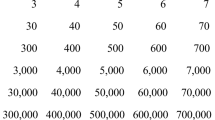Abstract
This study is focused on the relational thinking of first-grade students following their first 3 months of instruction from the Measure Up (MU) curriculum, an adaptation of the El’konin-Davydov curriculum. Following Davydov’s outline of instructional material, the MU first-grade materials were designed to have students identify the quantitative attributes of objects, learn to designate the properties using certain symbols, and carry out elementary analyses of the relationships. Additionally, MU emphasized the use of specific, multiple concurrent representations so students could use concrete, diagrammatic, and symbolic ways to analyze comparisons and convey their findings. Our research focused on the characteristics of MU first-grade students’ thinking about relations without numbers. Additionally, we were interested in the role symbols had in their ability to communicate their thinking. We analyzed video recordings and transcriptions of six semi-structured student interviews and then reanalyzed the data for specific evidence of symbolic understandings. Recognizing MU as a symbolically structured environment, we connected our data to this paradigm. Our findings show that students were able to make direct and indirect comparisons and that they relied on symbolizing to explain their thinking. These results show further support for Davydov’s hypothesis––a non-numeric introduction to relational symbols can develop children’s theoretical thinking abilities by going beyond empirical ways of knowing.


Similar content being viewed by others
Notes
Learning activity here is understood in the Davydov way as “uchebnaia deiatenlnost.”
References
Carpenter, T. P., Levi, L., Franke, M. L., & Zeringue, L. K. (2005). Algebra in elementary school: Developing relational thinking. ZDM, 37(1), 53–59. https://doi-org.eres.library.manoa.hawaii.edu/10.1007/BF02655897. Accessed 21 June 2007.
Carraher, D. W., & Schliemann, A. D. (2007). Early algebra and algebraic reasoning. In Lester, F. K. Jr. (Ed.), Second handbook of research on mathematics teaching and learning (pp. 669–705). Information Age Publishing Inc.
Coles, A., & Sinclair, N. (2019a). Ritualisation in early number work. Educational Studies in Mathematics, 101, 177–194. https://doi.org/10.1007/s10649-018-9815-6
Coles, A., & Sinclair, N. (2019b). Re-thinking ‘concrete to abstract’ in mathematics education: Towards the use of symbolically structured environments. Canadian Journal of Science and Mathematics Teacher Education, 19, 465–480. https://doi-org.eres.library.manoa.hawaii.edu/10.1007/s42330-019-00068-4. Accessed 15 Jan 2020.
Corbin, J. & Strauss, A. (2008). Basics of qualitative research. Sage Publications, Inc.
Davydov, V. V. (1975a). Logical and psychological problems of elementary mathematics as an academic subject. In Steffe, L. P. (Ed.), Children’s capacity for learning mathematics: Soviet studies in the psychology of learning and teaching mathematics, Vol. VII (pp. 55–107). University of Chicago.
Davydov, V. V. (1975b). The psychological characteristics of the “prenumerical” period of mathematics instruction. In Steffe, L. P. (Ed.), Children’s capacity for learning mathematics. Soviet studies in the psychology of learning and teaching mathematics, Vol. VII (pp. 109–205). University of Chicago.
Davydov, V. V. (2008). Problems of developmental instruction: A theoretical and experimental psychological study. In Lektorsky, V. & Robbins, D. (Eds.), P. Moxhay (Trans.), L. V. Bertsfai. (Comp.). International perspectives in non-classical psychology. Nova Science.
Davydov, V. V., Gorbov, S. F., Mikulina, G. G., Savelyeva, O. V., & Tabachnikova, N. L. (1999). Mathematics teaching grade 1. Miros.
Dougherty, B. (2008). Measure Up: A quantitative view of early algebra. In Kaput, J. J., Carraher, D. W. and Blanton, M. L. (Eds.), Algebra in the early grades (pp. 389–412). Taylor & Francis.
Eriksson, H., & Eriksson, I. (this issue). Learning actions indicating algebraic thinking in multilingual classrooms. Education Studies in Mathematics. https://doi.org/10.1007/s10649-020-10007-y
Freiman, V., & Fellus, O. (this issue). Closing the gap on the map: Davydov’s contribution to current Early Algebra discourse in light of the 1960s Soviet debates over word-problem solving. Education Studies in Mathematics. https://doi.org/10.1007/s10649-020-09989-6
Freudenthal, H. (1991). Revisiting mathematics education. Kluwer Academic Publishers Group.
Hattikudur, S., & Alibali, M. W. (2010). Learning about the equal sign: Does comparing with inequality symbols help? Journal of Experimental Child Psychology, 107, 15–30.
Polotskaia, E., & Savard, A. (2018). Using the relational paradigm: Effects on pupils’ reasoning in solving additive word problems. Research in Mathematics Education, 20(1), 70–90.
Sáenz-Ludlow, A., & Walgamuth, C. (1998). Third graders’ interpretations of equality and the equal symbol. Educational Studies in Mathematics, 35, 153–187.
Sarama, J., & Clements, D. H. (2009). Early childhood mathematics education research, learning trajectories for young children. Routledge.
Schmittau, J. (2004). Vygotskian theory and mathematics education: Resolving the conceptual-procedural dichotomy. European Journal of Psychology of Education, 19(1), 19–43.
Schmittau, J., & Morris, A. (2004). The development of algebra in the elementary mathematics curriculum of VV. Davydov. The Mathematics Educator, 8(1), 60–87.
Sophian, C. (2007). The origins of mathematical knowledge in childhood. Lawrence Erlbaum Associates.
Stephens, A. C., Ellis, A. B., Blanton, M., & Brizuela, B. M. (2017). Algebraic thinking in the elementary and middle grades. In Cai, J. (Ed.), Compendium (pp. 386–420). NCTM.
Tuominen, J., Andersson, C., Björklund Boistrup, L., & Eriksson, I. (2018). Relate before calculate: Students’ ways of experiencing relationships between quantities. Didactica Mathematicae, 40, 5–33.
Zuckerman, G. (2004). Development of reflection through learning activity. European Journal of Psychology of Education, XIX(1), 9–18.
Author information
Authors and Affiliations
Corresponding author
Additional information
Publisher’s note
Springer Nature remains neutral with regard to jurisdictional claims in published maps and institutional affiliations.
Rights and permissions
About this article
Cite this article
Venenciano, L.C.H., Yagi, S.L. & Zenigami, F.K. The development of relational thinking: a study of Measure Up first-grade students’ thinking and their symbolic understandings. Educ Stud Math 106, 413–428 (2021). https://doi.org/10.1007/s10649-020-10014-z
Accepted:
Published:
Issue Date:
DOI: https://doi.org/10.1007/s10649-020-10014-z




